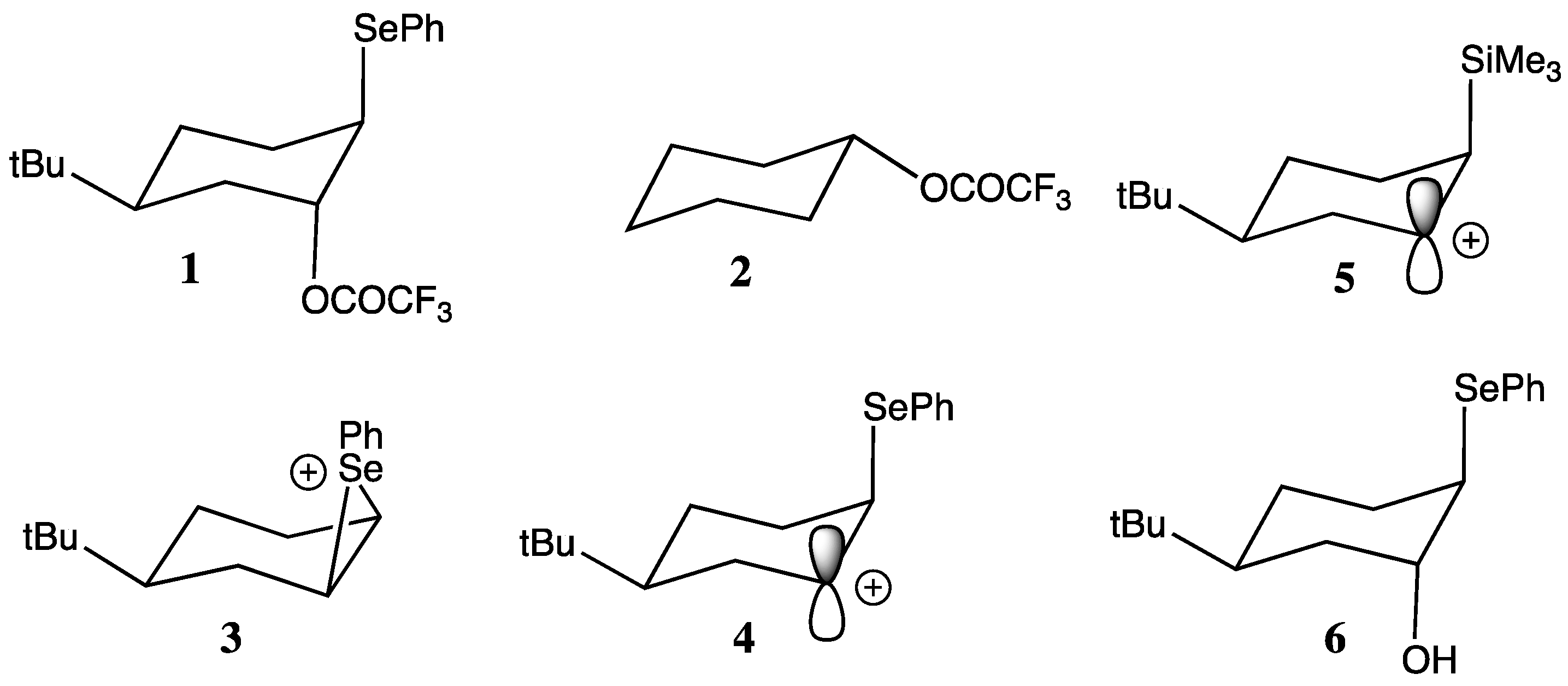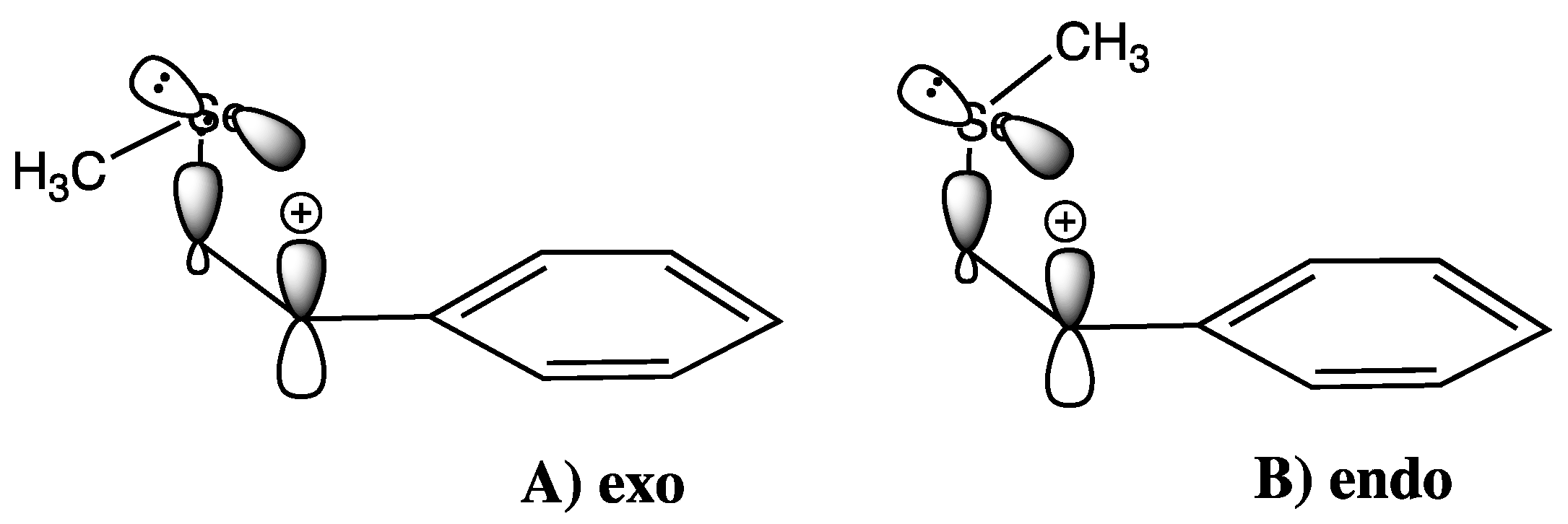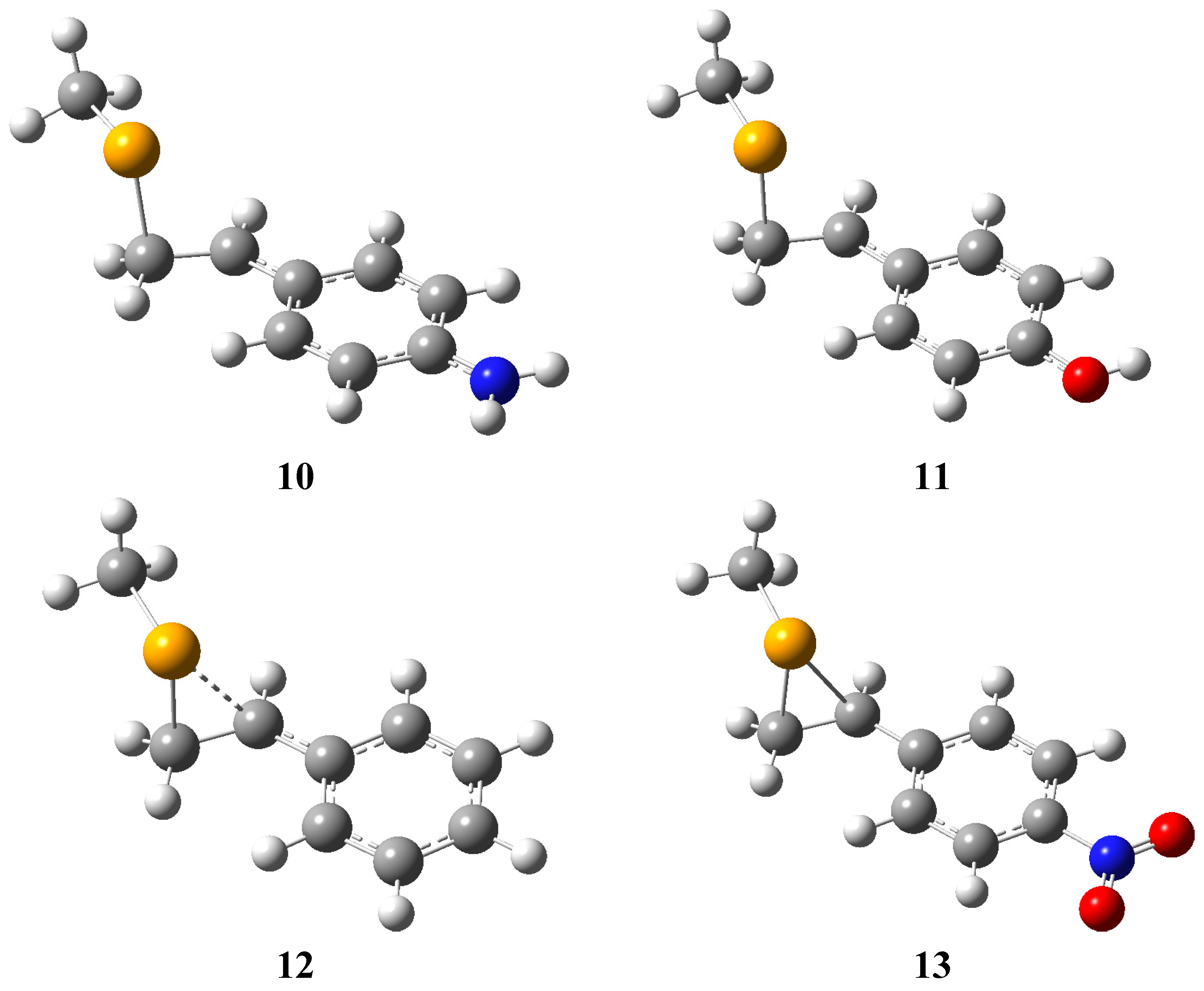Modes of Neighbouring Group Participation by the Methyl Selenyl Substituent in β-Methylselenylmethyl-substituted 1-Phenylethyl Carbenium Ions
Abstract
:1. Introduction




2. Methods
3. Results and Discussion


| 10 | 11 | 12 | 13 | |
|---|---|---|---|---|
| Se-CH2 (Å) | 2.012 | 2.011 | 2.010 | 2.010 |
| Se-CH2-C+ (°) | 98.84 | 93.41 | 84.78 | 78.96 |
| Se…C(+) Å | 2.664 | 2.554 | 2.372 | 2.245 |
| C(Ar)-C+ | 1.389 | 1.403 | 1.423 | 1.452 |
| pKR+ a | −12.4 [ 22] | <−20 [ 23] | ||
| Vertical interaction E(2) (kJ mol−1) | 55.7 | 73.3 | 211.6 | - |
| σC-Seenergy (a.u.) | −0.641 | −0.653 | −0.660 | |
| σC-Sepopulation | 1.891 | 1.866 | 1.820 | |
| Overlap, F(i,j) (a.u.) | 0.076 | 0.087 | 0.139 | |
| Nonvertical interaction E(2) (kJ mol−1) | 17.2 | 49.0 | 418.4 | - |
| nSeenergy (a.u.) | −0.363 | −0.379 | −0.397 | |
| nSepopulation | 1.799 | 1.727 | 1.606 | |
| F(i,j) (a.u.) | 0.037 | 0.046 | 0.083 |
4. Conclusions
Supplementary Materials
Acknowledgments
Conflicts of Interest
References
- White, J.M.; Lambert, J.B.; Spiniello, M.; Jones, S.A.; Gable, R.W. Vertical and Nonvertival Participation by Sulfur, Selenium, and Tellurium. Chem. Eur. J. 2002, 8, 2799–2811. [Google Scholar] [CrossRef]
- Capon, B.; McManus, S.P. Neighbouring Group Participation; Plenum Press: New York, NY, USA, 1976; Volume 1. [Google Scholar]
- Traylor, T.G.; Berwin, H.J.; Jerkunica, M.L. σ–π Conjugation: Occurrence and magnitude. Pure Appl. Chem. 1972, 30, 599–606. [Google Scholar]
- Hanstein, W.; Berwin, H.J.; Traylor, T.G. Modes of Carbonium Ion Stabilization. Evidence from Charge-Transfer Spectra. J. Am. Chem. Soc. 1970, 92, 829–835. [Google Scholar] [CrossRef]
- Hanstein, W.; Berwin, H.J.; Traylor, T.G. σ–π onjugation of Carbon-Metal Bonds. Stereoelectronic and Inductive Effects. J. Am. Chem. Soc. 1970, 92, 7476–7477. [Google Scholar]
- Traylor, T.G.; Hanstein, W.; Berwin, H.J.; Clinton, N.A.; Brown, R.S. Vertical Stabilization of Cations by Neighbouring Sigma-Bonds- General Considerations. J. Am. Chem. Soc. 1971, 93, 5715–5725. [Google Scholar] [CrossRef]
- Lambert, J.B. The Interaction of Silicon with Positively Charged Carbon. Tetrahedron 1990, 46, 2677–2899. [Google Scholar] [CrossRef]
- Lambert, J.B.; Zhou, Y.; Emblidge, R.W.; Salvador, L.A.; Liu, X.Y.; So, J.H.; Chelius, E.C. The β effect of silicon and related manifestations of σ conjugation. Acc. Chem. Res. 1999, 32, 183–190. [Google Scholar] [CrossRef]
- White, J.M.; Clark, C. Stereoelectronic Effects of Group 4 Metal substituents in Organic Chemistry. In Topics in Stereochemistry; Denmark, S., Ed.; John Wiley and Sons: New York, NY, USA, 1999; Volume 22, Chapter 3. [Google Scholar]
- White, J.M. Reactivity and Ground State Effects of Silicon. Aust. J. Chem. 1995, 48, 1227–1251. [Google Scholar] [CrossRef]
- Lim, S.F.; Harris, B.L.; Blanc, P.; White, J.M. Orbital interactions in selenylmethyl substituted pyridinium ions and carbenium ions with higher electron demand. J. Org. Chem. 2011, 76, 1673–1682. [Google Scholar] [CrossRef]
- McLeod, R.G.; Johnson, B.D.; Pinto, B.M. A Generalized exo-Anomeric Effect. Substituent and Solvent Effects on the Conformational Equilibria of 2-(Arylseleno)cyclohexanones. Israel. J. Chem. 2000, 40, 307–316. [Google Scholar] [CrossRef]
- Szabo, K.J.; Frisell, H.; Engman, L.; Piatek, M.; Oleksyn, B.; Sliwinski, J. α-(Phenylselenyl) ketones—Structure, molecular modeling and rationalization of their glutathione peroxidase-like activity. J. Molec. Struct. 1998, 448, 21–28. [Google Scholar] [CrossRef]
- Becke, A.D. Density Functional Thermochemistry 3. The Role of Exact Exchange. J. Chem. Phys. 1993, 98, 5648–5652. [Google Scholar] [CrossRef]
- McLean, A.D.; Chandler, G.S. Contracted Gaussian-Basis Sets for Molecular Calculations. J. Chem. Phys. 1980, 72, 5639–5648. [Google Scholar] [CrossRef]
- Krishnan, R.; Schlegel, H.B.; Pople, J.A. Derivative Studies in Configuration-Interaction. J. Chem. Phys. 1980, 72, 4654–4655. [Google Scholar] [CrossRef]
- Clark, T.; Chandrasekhar, J.; Spitznagel, G.W.; Schleyer, P.V.R. Efficient Diffuse Function-Augmented Basis Sets for Anion Calculations. III. The 3–21+G Basis Set for First Row Elements, Li-F. J. Comp. Chem. 1983, 4, 294–301. [Google Scholar] [CrossRef]
- Frisch, M.J.; Pople, J.A.; Binkley, J.S. Self Consistent Molecular Orbital Methods. 25. Supplementary Functions for Gaussian Basis Sets. J. Chem. Phys. 1984, 80, 3265–3269. [Google Scholar] [CrossRef]
- Alabugin, I.V.; Manoharan, M. Zeidan, Stereoelectronic effects and general trends in hyperconjugative acceptor ability of σ bonds, T.A. J. Am. Chem. Soc. 2002, 124, 3175–3185. [Google Scholar] [CrossRef]
- Glendening, E.D.; Reed, A.E.; Carpenter, J.E.; Weinhold, F. NBO; Version 3.1; Theoretical Chemistry Institute, University of Wisconsin: Madison, WI, USA, 1990. [Google Scholar]
- Frisch, M.J.; Trucks, G.W.; Schlegel, H.B.; Scuseria, G.E.; Robb, M.A.; Cheeseman, J.R.; Montgomery, J.A., Jr.; Vreven, T.; Kudin, K.N.; Burant, J.C.; et al. Gaussian 03; Revision C.02; Gaussian, Inc.: Wallingford, CT, USA, 2004. [Google Scholar]
- Toteva, M.M.; Moran, M.; Amyes, T.L.; Richard, J.P. Substituent Effects of Carbocation Stability: The pK(R) for p-quinonemethide. J. Am. Chem. Soc. 2003, 125, 8814–8819. [Google Scholar] [CrossRef]
- Amyes, T.L.; Richard, J.P.; Novak, M. Experiments and Calculations for Determinations of the Stabilities of Benzyl, Benzhydryl, and Fluorenyl Carbocations—Antiaromaticity Revisited. J. Am. Chem. Soc. 1992, 114, 8032–8041. [Google Scholar] [CrossRef]
- Sample Availability: Not available.
© 2013 by the authors; licensee MDPI, Basel, Switzerland. This article is an open access article distributed under the terms and conditions of the Creative Commons Attribution license (http://creativecommons.org/licenses/by/3.0/).
Share and Cite
Harris, B.L.; White, J.M. Modes of Neighbouring Group Participation by the Methyl Selenyl Substituent in β-Methylselenylmethyl-substituted 1-Phenylethyl Carbenium Ions. Molecules 2013, 18, 11705-11711. https://doi.org/10.3390/molecules181011705
Harris BL, White JM. Modes of Neighbouring Group Participation by the Methyl Selenyl Substituent in β-Methylselenylmethyl-substituted 1-Phenylethyl Carbenium Ions. Molecules. 2013; 18(10):11705-11711. https://doi.org/10.3390/molecules181011705
Chicago/Turabian StyleHarris, Benjamin L., and Jonathan M. White. 2013. "Modes of Neighbouring Group Participation by the Methyl Selenyl Substituent in β-Methylselenylmethyl-substituted 1-Phenylethyl Carbenium Ions" Molecules 18, no. 10: 11705-11711. https://doi.org/10.3390/molecules181011705




